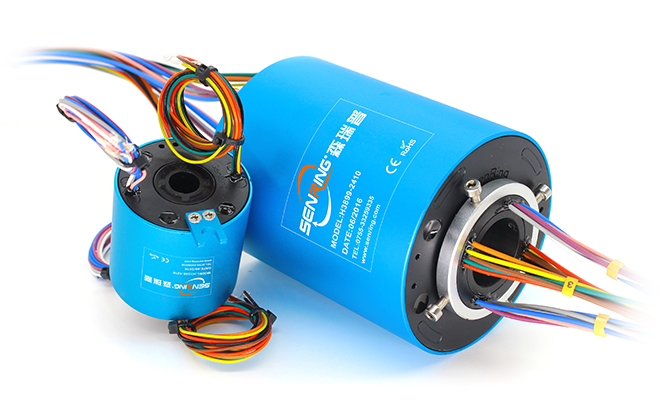Slip rings are essential components in various industries where the transmission of electrical signals or power between rotating and stationary parts is required. Through-hole slip rings, in particular, provide a reliable solution for applications involving high-speed rotations.
However, like any technology, there are potential challenges associated with their use at high speeds. In this article, we will explore these challenges, their implications, and potential solutions. So, let's delve deeper into the world of through-hole slip ring and uncover the obstacles that need to be addressed when operating them at high speeds.
The Basics of Through-Hole Slip Rings
Before we delve into the potential challenges, let's start by understanding the basics of through-hole slip rings. These devices are designed to facilitate the transfer of electrical signals, power, or data across rotating and stationary interfaces. With a central hole in their structure, through-hole slip rings allow cables, fluid hoses, or other components to pass through, enabling continuous rotation without any limitations.
Through-hole slip rings find applications in a wide range of industries, including robotics, aerospace, wind turbines, medical equipment, and many more. They play a crucial role in enabling seamless communication and power transmission between stationary and rotating parts, ensuring the smooth operation of various systems.
Potential Challenges of Using Through-Hole Slip Ring at High Speeds
1. Signal Degradation and Loss
At high speeds, one of the primary challenges faced when using through-hole slip rings is signal degradation and loss. The rotational motion and high frequencies involved can introduce noise and interference, resulting in a reduction in signal quality. This can lead to data errors, communication failures, or even system malfunctions.
To mitigate this challenge, proper shielding techniques should be employed to minimize electromagnetic interference (EMI). Additionally, using slip rings with low electrical resistance and high-frequency capabilities can help maintain signal integrity even at high speeds.
2. Friction and Wear
Another challenge associated with high-speed applications of through-hole slip rings is increased friction and wear. The continuous rotation at high velocities can generate heat and cause mechanical stress on the contacting surfaces of the slip rings. This can lead to accelerated wear, decreased reliability, and potential damage to the system.
To address this challenge, it is essential to select slip rings with high-quality materials, such as precious metals or specialized coatings, that can withstand the demands of high-speed rotations. Regular maintenance, lubrication, and monitoring of the slip rings can also help prolong their lifespan and minimize wear.
3. Heat Dissipation
High-speed operations of through-hole slip rings generate heat due to factors like electrical resistance, mechanical friction, and power dissipation. If not properly managed, excessive heat can result in overheating, affecting the performance and longevity of the slip rings as well as the entire system.
To combat this challenge, slip rings should be designed with efficient heat dissipation mechanisms such as cooling fins, fans, or liquid cooling systems. Proper thermal management can help maintain the temperature within acceptable limits, ensuring optimal performance and preventing thermal-related issues.
4. Mechanical Stress and Vibration
The centrifugal forces and mechanical stress experienced during high-speed rotations can introduce vibration and strain on through-hole slip rings. This can lead to structural deformations, misalignment, or even component failure, jeopardizing the overall reliability and safety of the system.
To address this challenge, slip ring should be engineered to withstand mechanical stress and vibration. Reinforcing the structural integrity, implementing precision manufacturing techniques, and using high-quality bearings can help minimize the impact of mechanical forces and ensure the smooth operation of the slip rings even at high speeds.
5. Contact Maintenance
Maintaining proper electrical contact between the rotating and stationary parts of through-hole slip rings is crucial for uninterrupted signal and power transmission. However, at high speeds, the continuous motion can cause increased contact wear, oxidation, and contamination, leading to poor connectivity and potential failures.
To overcome this challenge, regular inspection and cleaning of the slip rings are necessary. Employing self-cleaning or self-wiping mechanisms within the slip ring design can also help prevent contact-related issues. Furthermore, selecting slip rings with gold-plated or noble metal brushes can enhance contact reliability and minimize maintenance requirements.
Conclusion
Through-hole slip rings offer valuable solutions for high-speed applications that require the transmission of electrical signals, power, or data between rotating and stationary parts. While they present numerous benefits, there are potential challenges that need to be addressed to ensure optimal performance. By understanding and proactively mitigating these challenges, such as signal degradation, friction and wear, heat dissipation, mechanical stress, and contact maintenance, the reliable and efficient operation of through-hole slip rings at high speeds can be achieved.
Remember to select high-quality slip rings, implement proper maintenance practices, and consider alternative solutions when necessary. With careful attention to these challenges, through-hole slip rings can continue to revolutionize various industries and enable cutting-edge technologies.





Comments